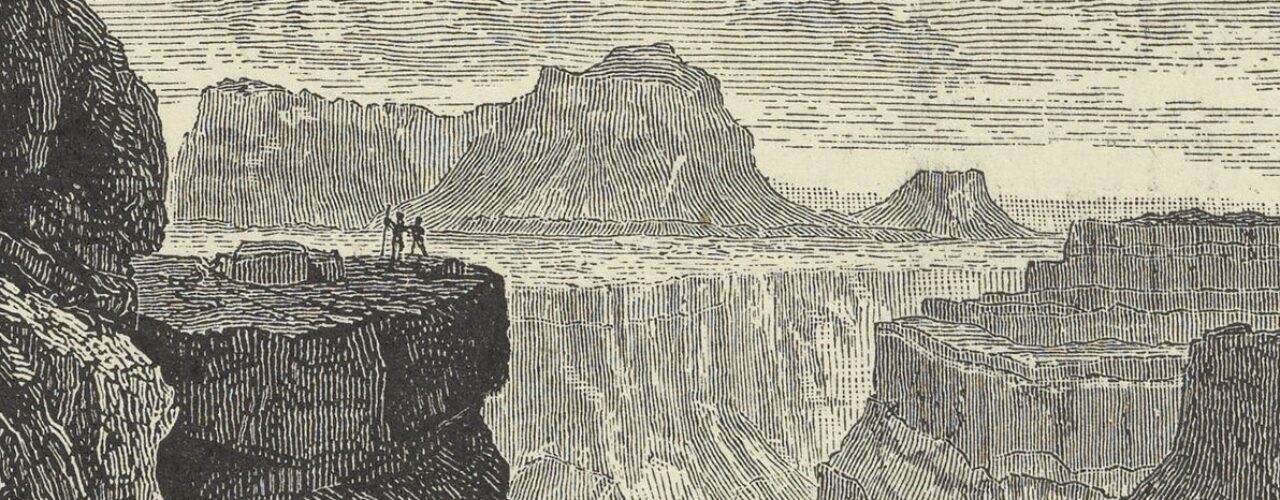Natural Passions
How protected lands inspire scientific pursuits.

How protected lands inspire scientific pursuits.
On February 26, 2023, the Grand Canyon will celebrate its 104th anniversary as a United States national park. A protected area since 1893, Grand Canyon National Park is one of the most recognized sites in the U.S. national park system, and certainly one of the most visited. Perhaps more surprising is the number of appearances the Grand Canyon makes in the Science History Institute’s digital collections.
One of my favorite items is a rare book titled Princess & Fairy, or, The Wonders of Nature. Written by Lily Martyn and published in 1899, the book uses narration and illustrations to captivate young readers through the “wonders of nature.” In the “All About Rivers” chapter, the fairy explains how rivers are formed and how they create valleys. “We should try to understand what water is able to do,” the fairy encourages a rapt princess (p. 139). “Your Highness would be astonished to see what a river in America, the Colorado River, has managed to do!” (p. 138).
The fairy then tells the princess that the walls in the Grand Canyon are more than a mile high in some places. “[A]ll that deep, deep channel has been cut by the Colorado River. It began at the top, on the surface, ages ago, and has been slowly working its way downwards ever since,” she explains (p. 140). After learning more about the Grand Canyon, the princess is eager to visit. “What a sight that must be! When I grow up I shall travel,” the princess exclaims (p.140).
We often see a similar excitement for the natural world in our oral history interviews of scientists and engineers. As a matter of fact, childhood time spent in nature is often the spark that encourages someone to become a scientist. Take biochemist Michael R. Koelle, for example.
A love of nature often leads to a love of the national parks. In fact, 56 oral history interviews include references to national parks—and not just U.S. sites. Below are just a few highlights of what our interviewees have to say about national parks around the world.
An artist and a scientist, Helen Donis-Keller describes traveling to Iceland and Death Valley to take photographs for a project of extreme environments at the boundaries of tectonic plates. As part of her interview, she showed some photographs she took at Death Valley to the interviewer.
As she mentions in her interview, artists draw from their backgrounds; for Donis-Keller, that’s science. She also feels fortunate to have a joint appointment at Olin College of Engineering as a professor of biology and art where she tries to instill an appreciation for art in aspiring scientists and engineers.
Lilianna Solnica-Krezel, a scientist who immigrated to the U.S. from Poland, mentions both a U.S. national park—Acadia National Park—and a Polish national park—Białowieża Forest—in her oral history interview, both of which she enjoyed visiting.
For Solnica-Krezel, such trips offered welcome breaks from her postdoctoral fellowship in Wolfgang Driever’s lab at Massachusetts General Hospital in Boston. On her commute to the lab, she only passed a single tree.
In his interview, Jonathon Howard describes growing up in a suburb of Sydney, Australia, near Ku-Ring-Gai National Park where he camped, fished, hiked, and swam.
Although Howard didn’t enjoy school, he loved the time he spent outside. One of the high schools he attended didn’t have a science or math teacher, but camping, hiking, snorkeling, spearfishing, and surfing showed him the beauties of the natural world.
Throughout our oral histories, interviewees like Donis-Keller, Solnica-Krezel, and Howard illustrate how the national parks—and the natural world in general—are wonderful sites for inspiring young people to pursue scientific careers and for offering restorative breaks from professional worlds.
And April 22–30, 2023, is National Park Week in the United States. Entrance fees are waived on the first day, so it’s a great time to find inspiration or escape at your local (or not so local) national park.
Audiograms created by Mia Jackson, the Institute’s digital engagement editor.
Featured image: View on the Colorado River, detail of an illustration from Princess & Fairy, or, The Wonders of Nature, 1899. Science History Institute.
How does a museum and library negotiate biography, civics, and the history of science?
Searching for the cats hiding in our collections.
The Science History Institute’s Othmer Library announces the winners of its 2025 After Hours comic book caption contest.
Copy the above HTML to republish this content. We have formatted the material to follow our guidelines, which include our credit requirements. Please review our full list of guidelines for more information. By republishing this content, you agree to our republication requirements.